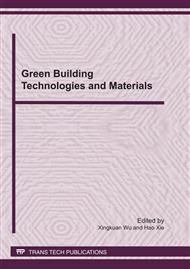p.175
p.179
p.185
p.192
p.198
p.205
p.210
p.216
p.220
Studies on Ecological Strategies of Architectural Environment of Small-Scale Landscape Based on Climate Adaptability
Abstract:
With the development of economy, pollutions of energy and environment have severely threatened the survival of human beings. Besides, the increasing population and disordered urban expansion also have aroused the deterioration of urban hardening and heat island effect. Therefore, effective ecological design strategies of landscape will become the key point to deal with the current situation. While microclimate, as one of the most significant elements to improve small-scale landscape, requires much more attention. Based on such thought, the thesis takes pains to analyze the different impacts on thermal comfort caused by soft landscape and hard landscape in urban architectural environment, and to put forward ecological design strategies of pavements in urban architectural landscape from the aspect of feasibility.
Info:
Periodical:
Pages:
198-204
Citation:
Online since:
April 2011
Price:
Сopyright:
© 2011 Trans Tech Publications Ltd. All Rights Reserved
Share:
Citation:


